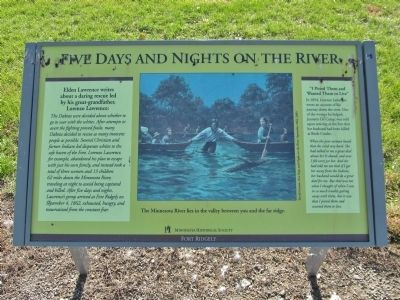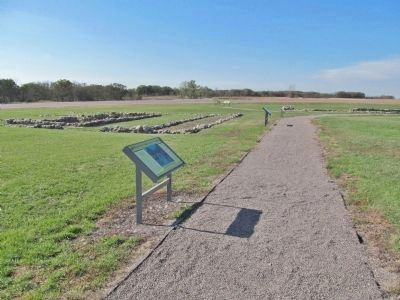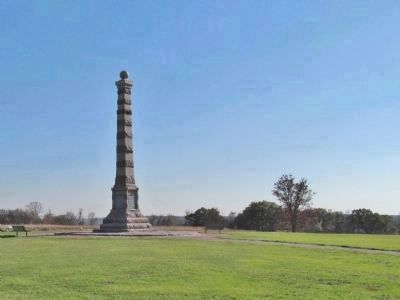Near Fairfax in Nicollet County, Minnesota — The American Midwest (Upper Plains)
Five Days and Nights on the River
Elden Lawrence writes about a daring rescue led by his great-grandfather, Lorenzo Lawrence:
The Dakota were divided about whether to go to war with the whites. After attempts to avert the fighting proved futile, many Dakota decided to rescue as many innocent people as possible. Several Christian and farmer Indians led desperate whites to the safe haven of the Fort. Lorenzo Lawrence, for example, abandoned his plans to escape with just his own family, and instead took a total of three women and 13 children 62 miles down the Minnesota River, traveling at night to avoid being captured and killed. After five days and nights, Lawrence's group arrived at Fort Ridgely on September 4, 1862, exhausted, hungry, and traumatized from the constant fear.
"I Pitied Them and Wanted Them to Live"
In 1894, Lorenzo Lawrence wrote an account of his journey down the river. One of the women he helped, Jannette De Camp, was told upon arriving at the fort that her husband had been killed at Birch Coulee.
When the poor woman heard that she cried very hard. She had talked to me a great deal about her husband, and now I felt sorry for her. And she had told me too that if I got her away from the Indians, her husband would do a great deal for me. But that was not what I thought of when I was in so much trouble getting away with them, but it was that I pitied them and wanted them to live.
The Minnesota River lies in the valley between you and the far ridge.
Fort Ridgely
Erected by the Minnesota Historical Society.
Topics and series. This historical marker is listed in these topic lists: Forts and Castles • Native Americans • Wars, US Indian. In addition, it is included in the Minnesota Historical Society series list. A significant historical month for this entry is September 1791.
Location. 44° 27.154′ N, 94° 44.074′ W. Marker is near Fairfax, Minnesota, in Nicollet County. Marker can be reached from County Highway 30, 1.1 miles west of State Highway 4, on the right when traveling west. Marker is in Fort Ridgely State Park; fee area – a Minnesota state park vehicle permit is required. Touch for map. Marker is at or near this postal address: 72404 County State Aid Highway 30, Fairfax MN 55332, United States of America. Touch for directions.
Other nearby markers. At least 8 other markers are within walking distance of this marker. A Doctor's Life (a few steps from this marker); Surgeon's Quarters—Headquarters (a few steps from this marker); Officers' Quarters—C (within shouting distance of this marker); Officers' Quarters—B (within shouting
distance of this marker); Fort Ridgely State Monument (within shouting distance of this marker); A Second Wave of Attacks (within shouting distance of this marker); Surprise Attack at Redwood Ferry (within shouting distance of this marker); Reinforcements Arrive (within shouting distance of this marker). Touch for a list and map of all markers in Fairfax.
More about this marker. caption: David Geister, Five Days and Nights on the River, September 1862, 2005
Also see . . .
1. The Sioux Massacre, Minnesota. "When all was ready the signal gun was fired, and in an instant the air was filled with war whoops, and the street with painted demons. The startled inhabitants ran to the doors of their houses and shops and stores, only to be shot down. The love of plunder soon drew them away from the work of slaughter, and many of the citizens succeeded in escaping." (Submitted on April 9, 2014.)
2. 1862 Dakota War. "War parties fanned out across the valley on both sides of the river. It was open season on whites. Men, women and children were killed in the fields, in their homes and in their beds. Hundreds
of other women and children were taken captive to be used as hostages or slaves later on... others sounded the alarm, shielded their white neighbors and helped them reach safety. Escape was a relative term since the Dakota were all over the place. Some people successfully evaded the marauders, often while bleeding, burned and with children. Soon, there were so many refugees that they just got on the road and made a run for it. Resistance in those early hours was futile and death was everywhere." (Submitted on April 9, 2014.)
Additional keywords. U.S.-Dakota War of 1862
Credits. This page was last revised on August 6, 2021. It was originally submitted on April 9, 2014, by Keith L of Wisconsin Rapids, Wisconsin. This page has been viewed 727 times since then and 28 times this year. Photos: 1, 2, 3. submitted on April 9, 2014, by Keith L of Wisconsin Rapids, Wisconsin.


